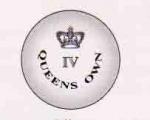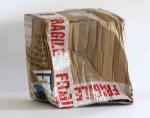-
Posts
1,761 -
Joined
-
Last visited
-
Days Won
3
Content Type
Profiles
Forums
Blogs
Gallery
Events
Store
Everything posted by Stuart Bates
-
I recently attempted to answer a question on a uniform ID and the NCO in the photograph is wearing the "round" or "station-master" forage cap. http://gmic.co.uk/in...729#entry450729 In trying to date the photo I began to wonder when the peaked/visor cap that we know so well today was first used. It is mentioned, with photograph plate 8 in the 1900 DRs, and co-existed with the round cap. It was called "Staff Pattern" and the earliest photograph that I have seen is of General Sir George White's HQ (1899) at Ladysmith which clearly shows an officer wearing one. And Indeed a painting of the Relief of Ladysmith shows Sir George White and other officers wearing this style (1900) http://en.wikipedia....erick_Bacon.jpg There are plenty of photos showing Generals and staff wearing these caps during the 2nd Boer War but I haven't been able to locate any prior to the 1899 stated above. Going back to the 1894 DRs only the round forage cap is mentioned so we can assume from this that the peaked forage cap appeared after 1894 and probably say around 1898. I say this because the DRs always lagged behind the actuality of what officers wore. I think the cap had replaced the round style by 1902 when I think it also began to filter through to the general soldiery, that is, non staff but I shall have to do some more checking. Any help always appreciated. Stuart
-

Uniform ID
Stuart Bates replied to gerardkenny's topic in Great Britain: Militaria: Badges, Uniforms & Equipment
I forgot to say that the period is probably late 1880s to mid 1890s. Stuart -

Uniform ID
Stuart Bates replied to gerardkenny's topic in Great Britain: Militaria: Badges, Uniforms & Equipment
The badge on the forage cap would appear to be that described as "Garrison Staff" in plate 46 of the 1900 Dress Regulations, that is, the royal cypher surmounted by a crown. I know that the DRs refer to officers but this is a senior NCO, a law unto themselves. The collar and cuffs were of "blue cloth." OK, just did some more checking and Garrison Staff on temporary appointment could continue to wear the uniform of the unit from which they came. I don't know about the collar badges though. Inspectors of Army Schools also had the royal cypher surmounted by the crown but their forage cap had a gold lace band with a light blue stripe to its centre. Stuart -
Hi Shams, the second photo is described thus on - http://www.britishem...25thcav1890.htm "This detail is from a group photo of officers of the 5th and 2nd Punjab Cavalry taken at Muridki Camp in 1890. This senior officer seated at the right end is wearing the new tunic with the six rows of gold cords that are in straight groupings instead of plaited. The cords appear to be sewn together for neatness, contrasting with the less tidy cording of the 2nd Punjab officers standing behind him. The decoration at the end of the cords has changed to an Austrian knot in place of the trefoil, with extra loops added to the top cords on the shoulder. He has the pouchbelt with red and gold cord attached. His sword is more curved than before and the red and gold sabretache is clear to see. His helmet is on the floor by his feet. The red and green plume is attached to the top where in many photos a spike is in place. His hessian boots have no gold top edge or corded boss." But what strikes me is that the helmet appears to have the QVC whilst the sabretache has the KC. The 5th became the 25th Cavalry (Frontier Force) in 1903 so that would explain the KC. Perhaps the helmet plate just had not been changed after Victoria's death. This does not help with the cuff design which has an Austrian knot with lots of added embroidery. Stuart
-

4th Queen's Own Dragoons
Stuart Bates replied to TS Allen's topic in Great Britain: Militaria: Badges, Uniforms & Equipment
As to uniforms go to Franklin's book which shows the coatee style from circa 1793-1796 and 1798-1800 for officers and troopers. He also shows examples of the shorter version 180 and 1813. Stuart -

4th Queen's Own Dragoons
Stuart Bates replied to TS Allen's topic in Great Britain: Militaria: Badges, Uniforms & Equipment
TS, in 1768 the buttons are reported to be white metal not numbered. But in the following year they are stated as being of silver, presumably for officers, and numbered - see below. "The coatee buttons had the design of the Star of St. Patrick incised within the circle, above the shamrock was the number 'IV', the whole incised." I got this description from Military Shoulder Belt Plates and Buttons by Major H.G. Parkyn. There is an excellent book on British uniforms of the Napoleonic period by C.E. Franklin. -
I just had a question about Army Numbers answered, thanks Graham and Leigh, and thought that this site would prove very useful as an additional reference. It is probably well known to many members but for those that haven't come across it http://1914-1918.net/ This is the link to the numbering system introduced in 1920 http://1914-1918.net/renumbering20.htm and following is part of the first page. The author of the site allows up to half a page to be used and requests that the URL be specified. Stuart
-
Simon, would not the fact that it was Winter be the reason for the greatcoats? It was the 2nd of February - was that a particularly cold/rainy day? The London Weather says of February "Most of the month was dry, rather cloudy and fairly cold" and I have read that snow began to fall after Queen Victoria was placed in the Frogmore Mausoleum. Stuart
-

Humidity
Stuart Bates replied to Stuart Bates's topic in Preservation & Restoration of Military Artifacts
Dieter, My gadget shows both temperature and relative humidity. I shall look into it further but am hoping that a member has the answer Stuart -

Humidity
Stuart Bates replied to Stuart Bates's topic in Preservation & Restoration of Military Artifacts
Thanks Dieter. My de-humidifier does not seem capable of getting below the 50% mark. I shall have to investigate further. Stuart -

British helmets collection
Stuart Bates replied to pjac's topic in Great Britain: Militaria: Badges, Uniforms & Equipment
Patrick, if you remove the helmet plate you should be able to see how the centre is attached without disturbing anything. On my AVD the cypher had 3 pins which pierceed the black velvet and then went through a brass circular plate where they were bent over. The brass plate was secured to the rest of the plate by a cotter pin passing through a lug to the centre of that plate. Whatever you do just have a look and do not try to straighten the pins if they are there. BTW: another beautiful helmet. Stuart








